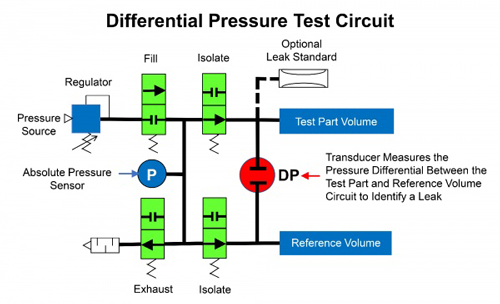Differential Pressure Decay Leak Detection - dP and dP/dT
Pressure decay leak tests involve measuring the drop in pressure on the interior of a part. To conduct the test, the air is injected into the test part until it reaches the target pressure. The air source is then cut to isolate the pressure and the loss of pressure (decay) is measured over a specified time. A loss in pressure greater than a setpoint indicates the presence of a leak.
Differential pressure decay leak testing uses traditional pressure decay parameters, but tests for leaks by measuring a pressure change between a reference volume of air and the test part volume. In differential pressure decay leak detection, the test measures the rate of pressure loss between the reference volume and the part volume as a leak. It is quick, reliable, and sensitive enough to detect very small leaks.
Differential pressure decay leak testing uses traditional pressure decay parameters, but tests for leaks by measuring a pressure change between a reference volume of air and the test part volume. In differential pressure decay leak detection, the test measures the rate of pressure loss between the reference volume and the part volume as a leak. It is quick, reliable, and sensitive enough to detect very small leaks.
dP and dP/dT Differential Pressure Leak Test Cycles
The pressure decay leak detection test cycle fills a test part and a reference volume to a specified test pressure. The air source is then cut off by the fill valve, the test pressure stabilizes, and the reference air isolation valves are closed as the exhaust valve is open, isolating pressure only on both sides of the differential pressure transducer. The transducer measures for a change in pressure between the test part volume and the non-leaking reference volume during the programmed test time.At the conclusion of the test, the instrument reports the change in the differential pressure. If the differential pressure decay is within the “high and low pressure window,” the part passes the leak test. If outside the target limits, the part fails the leak test and is rejected. Both tests use a differential pressure transducer to measure pressure loss correlated to a flow rate in scc/m. See the diagram.

Differential Pressure Decay Test Sensitivity
Depending on the testing application, differential pressure decay leak detection can provide a higher level of sensitivity than standard pressure decay tests. It is important to note that object size and testing interval can impact the sensitivity of the test—and it is not an ideal method for testing parts made from elastic materials.
Our instruments provide the following measurement ranges for differential pressure decay leak detection:
- Test pressure range: vacuum to 13.8 bar (gauge)
- Test pressure control accuracy: 1.5% FS
- Measuring range: 0 to 0.345 bar (differential)
- Measuring accuracy: ±0.006 % FS
- Resolution: 0.007 Pa
Versatile Differential Pressure and Pressure Decay Test Equipment
Cincinnati Test Systems’ differential pressure decay leak detection instruments provides both dP and dP/dT testing options. The dP test reports the “pressure drop” over the full test time, while the dP/dT test measures the pressure drop and reports the “ calculated pressure drop” identified as a pressure loss per one second.
The instruments are also designed to conduct calibrated differential pressure decay, and differential vacuum decay tests, creating a versatile solution that can be used across a range of testing applications.
The Sentinel MH, LPC 528, Sentinel C28, Blackbelt, Blackbelt Pro, and Sentinel I28 offer differential pressure decay testing.
Contact Us for Reliable, Customizable Differential Pressure Decay Test Systems
Cincinnati Test Systems designs and manufactures the most accurate and most reliable leak test systems on the market. Contact us today for the differential pressure decay testing solution you need.
.png?width=1200&height=400&name=Pressure%20Decay-1200x400-B-CTA%20(3).png)